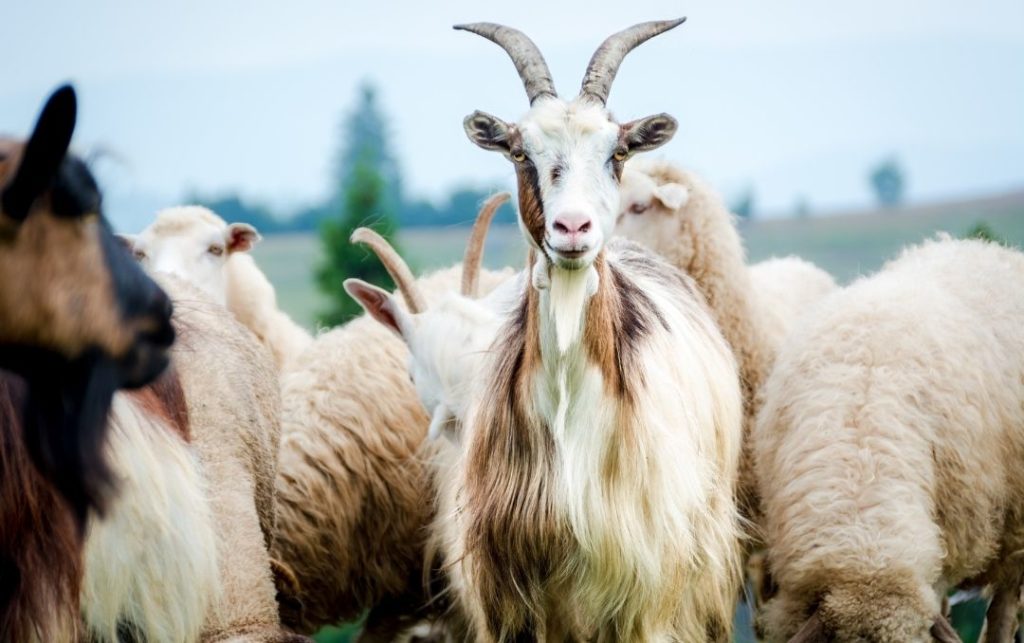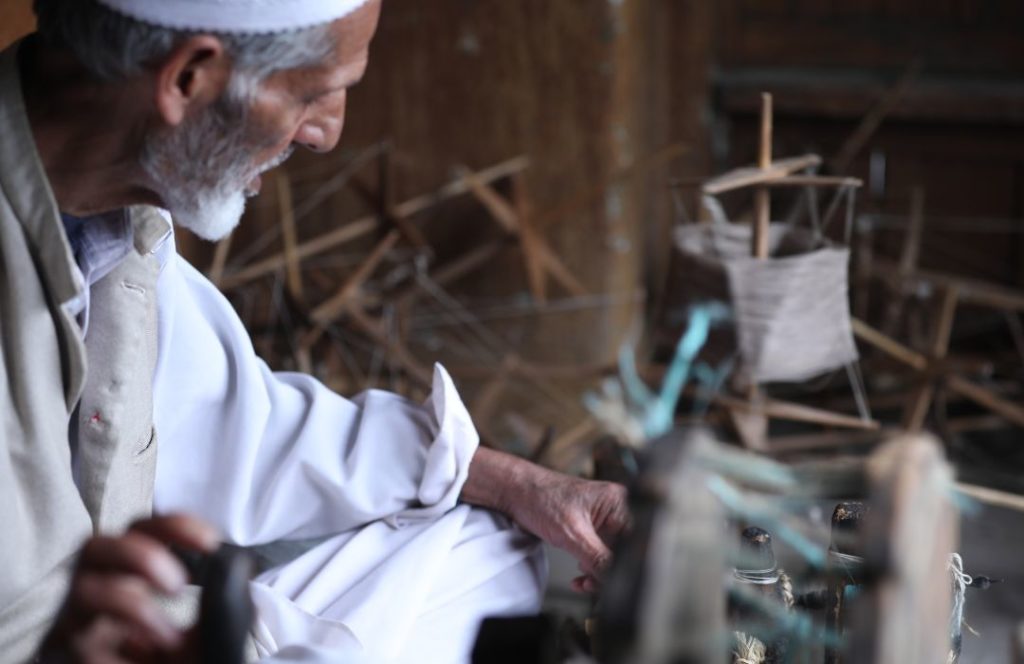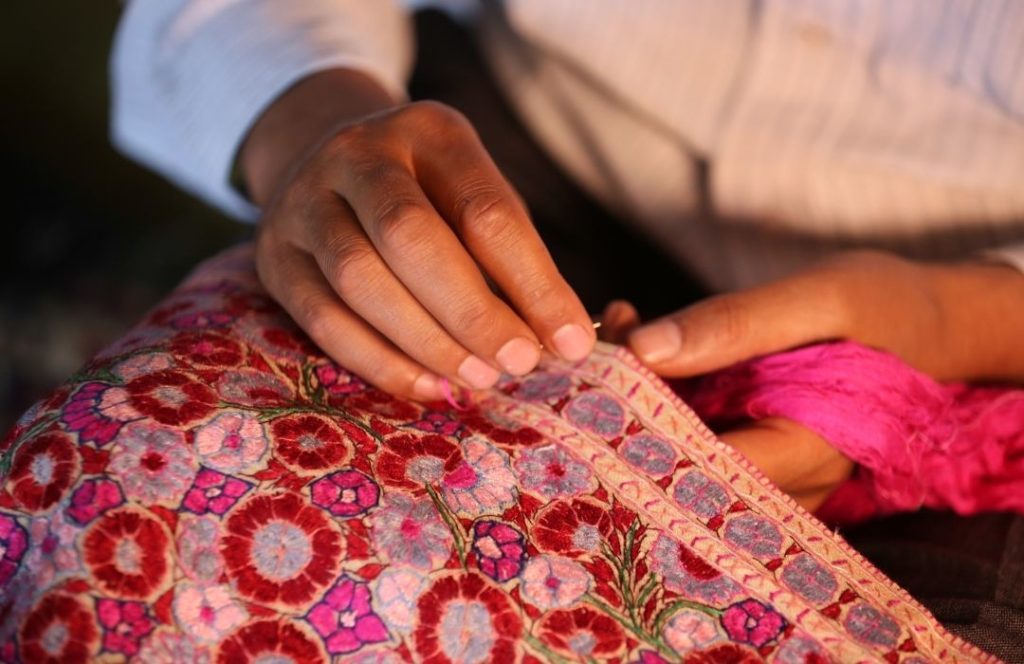In the misty valleys of Kashmir, tales of heritage fill the air. Here, a delicate thread weaves through time. It carries with it the legacy of luxury and craftsmanship. It is an accessory, so luxurious that it feels like a whisper against your skin. You begin to enter the enchanting world of Kashmiri Pashmina.
Pashmina - Definition and Origin
Pashmina is the art of converting immensely soft Cashmere wool into luxury products and accessories. People often call Cashmere "Soft Gold". It is not just a wool type but an embodiment of exceptional softness, unrivaled warmth, and a history steeped in opulence. Derived from the fine undercoat of the Changthangi goat, this exquisite textile has transcended its utilitarian purpose. It is but a symbol of regality, luxury, and unparalleled artistry.

As the looms echo in the valleys, Kashmiri Pashmina resonates with the cultural heartbeat of the region. Woven into the fabric of traditions, it has adorned royalty, graced auspicious occasions, and been passed down through generations. Also, people have always considered it as a cherished heirloom. Beyond being a textile, it is a living testament to the rich cultural tapestry of Kashmir, an art form that binds communities and defines identities.
The Authenticity Tag
Yet, as the world clamors for this timeless treasure, the integrity of Kashmiri Pashmina faces threats of imitation and adulteration. It is at this juncture that the Geographical Indication (GI) tag steps in as a guardian, a shield to protect the authenticity and heritage of this cultural gem. Hence, the GI tag becomes a beacon, guiding us through the intricate narrative of how Kashmiri Pashmina's unique identity is safeguarded against the tides of commercialization.
So, we embark on a journey through the looms of Kashmir, unraveling the mystique of Pashmina. We also understand its cultural resonance and examine how the Geographical Indication tag serves as a crucial guardian. Also, we understand the way the GI tag ensures that the soft echoes of this heritage resonate authentically across the globe. This exploration seeks to underscore the vital role the GI tag plays in preserving the essence of Kashmiri Pashmina. Note that Pashmina isn't merely a fabric but a living testament to the cultural heritage it represents.
Kashmiri Pashmina - A Heritage Unraveled
Pashmina's Origin and Craftsmanship:
Nestled in the lap of the Himalayas, the story of Kashmiri Pashmina begins with the Changthangi goat. Note that the goat is an inhabitant of the harsh terrains of Ladakh. This remarkable breed, adapted to survive in extreme cold, yields the finest and most sought-after undercoat wool. The rigorous winters coax the goat to develop a fleece that is softer and warmer than almost any other natural fiber. This luxury Cashmere wool sets the stage for the creation of Pashmina.

The traditional craftsmanship involved in transforming this raw material into the ethereal fabric is an art passed down through generations. Local artisans meticulously hand-spin the delicate fibers, producing a yarn so fine that it defies the limits of conventional weaving. The weaving process, often a closely guarded family secret, unfolds on the handloom. Skilled hands bring to life intricate patterns that have been woven into the cultural fabric of Kashmir for centuries. It is this artisanal finesse that elevates Kashmiri Pashmina beyond a mere textile, turning it into a masterpiece of craftsmanship.
Cultural Significance:
Kashmiri Pashmina is not just a garment but a living emblem of the cultural heritage of Kashmir. Woven into the intricate patterns are stories of generations, echoes of ceremonies, as well as the poetry of rituals. It is not uncommon to see people handing down Pashmina shawls as heirlooms. Moreover, these shawls carry with them the weight of tradition and familial blessings. In ceremonies, particularly weddings, the bride often wears a Pashmina shawl. It symbolizes not just warmth but also the rich cultural heritage artisans weaving into the fabric of her new life.
Beyond ceremonies, Pashmina is an integral part of daily life in Kashmir. From the warmth it provides during the biting winters to its use in religious ceremonies, the fabric is entwined with the daily rhythms of the Kashmiri people. The motifs woven into Pashmina tell tales of Chinars, the iconic trees of the region, and paisley patterns that carry a historical legacy. This cultural symbolism isn't just aesthetically pleasing but serves as a reminder of the roots Pashmina has in the Kashmiri populace.
Economic Impact:
The economic importance of the Pashmina industry in Kashmir is profound, reaching far beyond the looms and weaving households. Employment in this sector spans from nomadic herders in the Himalayan highlands to skilled artisans working in small workshops. The intricate craftsmanship involved in Pashmina production provides sustainable livelihoods for numerous families, hence ensuring that the tradition is passed down through generations.
Kashmiri Pashmina, with its global allure, serves as an ambassador for the region's craftsmanship. Additionally, it has become a significant contributor to Kashmir's exports. The international demand for this exquisite fabric has not only created a niche market for Kashmiri artisans but has also boosted the region's economy. Pashmina, once confined to the valleys of Kashmir, is now a global phenomenon. Moreover, its economic impact resonates not just in the remote villages where it is crafted but in the bustling markets around the world.
In the heartland of Kashmir, Pashmina is not just an art but a cultural artifact that has stood the test of time. Its origin, craftsmanship, cultural significance, and economic impact weave a narrative that transcends the fabric itself, telling the story of resilience, tradition, and the enduring legacy of Kashmir's soft gold.
Geographical Indication - Safeguarding Pashmina

Understanding Geographical Indication:
A Geographical Indication (GI) tag stands as a testament to the unique identity and characteristics of products originating from a specific geographical location. Hence, it is a recognition that the qualities, reputation, and attributes of the product are intrinsically linked to its origin. In the case of Kashmiri Pashmina, the GI tag becomes a shield, a mark of authenticity that separates it from imitations. It also reinforces the cultural and economic significance of Pashmina
From a legal perspective, a GI tag is a form of intellectual property protection. It guards against unauthorized use of the product's name and similar products trying to leverage its reputation. Economically, it creates a brand value for the product. So it attracts consumers who seek genuine and traditional, thus boosting the market for authentic products.
The Journey to GI Tag for Kashmiri Pashmina:
The journey towards securing a Geographical Indication tag for Kashmir Pashmina is a saga. It is marked by persistence, collaboration, and a collective determination to preserve the legacy of this cultural gem. In the early 2000s, the artisans, traders, and the government of Jammu and Kashmir embarked on the formidable task of securing recognition for Kashmiri Pashmina's unique geographical identity.
This journey wasn't without its challenges. The primary hurdle was distinguishing authentic Pashmina from the multitude of shawls flooding the market, often masquerading as the real deal. Counterfeiting posed a serious threat to the heritage and economic sustainability of the craft. The artisans and stakeholders navigated through these challenges. They presented exhaustive documentation, establishing the distinctiveness of the product, and engaging in advocacy at national and international levels.
The milestone of securing the GI tag for Kashmiri Pashmina was achieved in 2005. It was indeed a landmark moment that validated the centuries-old tradition and craftsmanship intrinsic to the region. This recognition elevated Kashmiri Pashmina beyond a commodity; it became a cultural ambassador, representing the heritage and skill of the Kashmiri artisans on the global stage.
Benefits of the GI Tag:
The GI tag is a guardian of the unique qualities that define Kashmir Pashmina. One of its key advantages is the protection it provides against counterfeiting. With the tag in place, only products genuinely originating from the specific geographic region can bear the prestigious label of Kashmiri Pashmina. This not only preserves the integrity of the craft but also ensures that consumers worldwide receive an authentic product.
The GI tag bestows upon Kashmir Pashmina a distinct identity in the market, amplifying its value. This recognition creates a niche market for genuine products, allowing artisans to command fair prices for their craftsmanship. The economic benefits extend beyond the weavers to the entire Pashmina ecosystem, encompassing herders, spinners, and traders. It serves as a testament to the cultural heritage embedded in each thread of the fabric.
Legal Framework and Regulations:
The legal framework surrounding the GI tag for Kashmir Pashmina involves stringent regulations to safeguard its authenticity. Any product labeled as Kashmir Pashmina must adhere to specific criteria, ensuring that the raw materials used, the production processes, and the geographical origin align with the defined standards. This regulatory framework is not only a measure to maintain the quality and authenticity of the product but also a means to protect the livelihoods of the artisans. It is, after all, the artisans, who have crafted it for centuries.
The recognition of Kashmir Pashmina under the GI tag brings with it a set of responsibilities and commitments. It mandates adherence to traditional methods, preserving the cultural and historical essence of the craft. These regulations not only protect the economic interests of the stakeholders but also serve as a custodian of the centuries-old tradition, ensuring that the art of Kashmir Pashmina endures for generations to come.
In the delicate folds of Kashmir Pashmina, the Geographical Indication tag weaves a narrative of protection, authenticity, and economic empowerment. It stands as a beacon, guiding consumers towards the genuine, preserving a cultural legacy, and fostering sustainability in the artisanal landscape of Kashmir.
Latest Additions to the GI
Geographical Indication (GI) protection plays a crucial role in safeguarding traditional crafts. Further, it ensures their unique identity and origin are recognized and protected. Here are a few crafts that have received GI protection:
Handspun Handwoven Pashmina:

Craft Description: One of the crafts that have been rewarded the GI tag is the hand-spun and handwoven Pashmina. The fiber count in these shawls lies between 12 to 15 microns. The meticulous process of hand spinning and handweaving Pashmina involves transforming the delicate fibers of the Pashmina goat into a luxurious textile. This craft is world-famous for its exceptional softness and warmth.
GI Protection: The GI tag for Handspun Handwoven Pashmina ensures that products made using this traditional method can only be labeled as such if they originate from the specific geographical region associated with this craft, typically Kashmir.
Sozni Embroidery:

Craft Description: Sozni embroidery is an intricate needlework technique that involves fine, detailed stitching. Artisans create elaborate patterns on Pashmina and other fabrics, adding a touch of elegance and sophistication to the finished product.
GI Protection: Sozni embroidery has received Geographical Indication protection, acknowledging its unique cultural and regional significance. This protection ensures that products featuring Sozni embroidery are authentic to the specific geographical area known for this craft.
Kani Shawls:

Craft Description: Kani shawls are renowned for their distinctive weave, known as the Kani weave. This intricate weaving technique involves using small wooden sticks, called kanis, to create vibrant and finely detailed patterns on the shawls.
GI Protection: The GI tag for Kani shawls signifies that this traditional craft is associated with a specific geographical location. It ensures that only shawls produced using the authentic Kani weave in the designated region can bear the prestigious label.
Also read: KASHMIRI SHAWLS DURING THE DOGRA PERIOD
Challenges to Protect Pashmina
While the Geographical Indication (GI) tag has been a pivotal milestone in safeguarding Kashmir Pashmina, challenges persist in the ever-evolving landscape of the global market. Enforcement of the GI tag, especially in international jurisdictions, remains a complex task. Despite stringent regulations, instances of imitation and unauthorized use of the Kashmir Pashmina label persist, posing a threat to the authenticity of the craft.
Global competition is another pressing challenge. The allure of the Pashmina name has led to a surge in demand. But it has also attracted a flood of imitations. Distinguishing between genuine Kashmir Pashmina and counterfeit products has become a constant battle. The market is saturated with products claiming to be authentic, diluting the exclusivity and value associated with genuine Kashmir Pashmina.
Additionally, economic pressures within the region, coupled with fluctuating geopolitical factors, can impact the supply chain and create vulnerabilities. These challenges necessitate continuous vigilance, effective international collaboration, and a robust legal framework. This will ensure the sustained protection of Kashmir Pashmina's unique identity.
Innovations in Pashmina Industry
In response to these challenges, the Pashmina industry has witnessed a wave of innovations. They are aimed at preserving the authenticity of the craft and ensuring its relevance in the contemporary market. Technology has played a significant role, with advancements in blockchain and RFID (Radio-Frequency Identification). These are being explored to create digital passports for each Pashmina product. This not only enhances traceability but also acts as a deterrent against counterfeit products.
Collaborations between traditional artisans and modern designers have given rise to innovative designs. This is further expanding the appeal of Kashmiri Pashmina beyond its traditional market. These collaborations not only breathe new life into the craft but also create avenues for the artisans to showcase their skills on a global platform.
Global Demand and Sustainable Practices:
The global demand for Kashmir Pashmina continues to surge, fueled by a growing appreciation for handmade, authentic products with a story. However, this demand brings its own set of challenges. Meeting the market demand while maintaining the integrity of the craft requires a delicate balance.
Sustainable practices have emerged as a guiding principle in the Pashmina industry. There is a growing emphasis on responsible sourcing of raw materials. This ensures the welfare of the Changthangi goats, and implements eco-friendly dyeing processes. These initiatives not only align with global sustainability goals but also resonate with consumers who are increasingly conscious of the environmental impact of their purchases.
The industry is also witnessing a shift towards ethical and fair trade practices. Collaborations with international organizations that champion ethical production and fair wages are becoming more common. These initiatives not only ensure the well-being of the artisans but also contribute to the positive perception of Kashmir Pashmina in the global market.
Future Prospects and Trends:
The future of Kashmir Pashmina holds both challenges and exciting possibilities. Emerging trends suggest a continued rise in demand for handmade, culturally rich products, aligning with the ethos of slow fashion. Consumers are increasingly valuing products with a story, and Kashmir Pashmina, with its centuries-old tradition, is well-positioned to cater to this demand.
The integration of technology, including e-commerce platforms and digital marketing, is expected to play a pivotal role in expanding the market reach of Kashmir Pashmina. Online platforms provide a direct link between artisans and consumers, eliminating intermediaries and ensuring a fairer distribution of profits.
However, staying relevant in a rapidly changing global landscape requires a proactive approach. Adapting to changing consumer preferences, embracing sustainable practices, and leveraging technology will be crucial. Furthermore, international collaborations and advocacy for the recognition of the GI tag on a broader scale will be essential to secure the future of Kashmir Pashmina as a global heritage.
In navigating these challenges and embracing innovative solutions, Kashmir Pashmina stands at a crossroads. The rich tapestry of tradition meets the dynamic forces of the modern market. The journey ahead requires a harmonious blend of heritage, innovation, and sustainable practices to ensure that the soft echoes of Kashmir's Pashmina continue to resonate across the world.
Beyond the Tag - Preserving the Essence of Kashmir Pashmina

Cultural and Artistic Evolution:
The journey of Kashmir Pashmina goes beyond the confines of a legal designation; it is a living testament to the dynamic interplay between tradition and evolution. The cultural and artistic aspects of Pashmina have not stagnated with the acquisition of the Geographical Indication (GI) tag; instead, they have embraced change while remaining rooted in their rich heritage.
Over time, Pashmina has undergone artistic metamorphosis, influenced by changing tastes and global trends. Traditional motifs that once adorned the fabric have seamlessly intertwined with contemporary designs. This has given rise to a diverse array of patterns. The shawls are not just garments; they are canvases, each thread narrating a story of cultural evolution. The artistic expression found in modern Pashmina pieces reflects the adaptability of the craft. It also ensures its relevance in today's fashion landscape.
Role of Artisans and Craftswomen:
While legal protections are essential, the true guardians of Kashmiri Pashmina's essence are the artisans. It is them who breathe life into every creation. Beyond the legal realm, it is their hands that meticulously spin the yarn, their eyes that envision the patterns, and their skills that ensure the fabric retains its timeless allure.
These artisans play a pivotal role in preserving the authenticity of Pashmina. Through their unwavering commitment to traditional techniques and their ability to infuse creativity into the craft, they bridge the gap between heritage and contemporary demands. The legacy of Pashmina is not confined to the fabric alone. But, it resides in the hands that shape it, in the stories woven into every thread, and in the commitment of artisans to pass down their skills through generations.
Community Initiatives:
Preserving the essence of Kashmir Pashmina extends beyond individual efforts; it is a collective responsibility woven into the fabric of communities. Community-driven initiatives have emerged as powerful forces in safeguarding the heritage of Pashmina, involving local communities, artisans, and various stakeholders.
One such initiative is the establishment of cooperative societies that empower artisans economically and provide a platform for collective decision-making. These cooperatives foster a sense of community among artisans, ensuring fair wages, ethical practices, and the preservation of traditional methods. By pooling resources and knowledge, artisans can navigate challenges collectively and contribute to the sustained growth of the Pashmina industry.
Education and awareness programs are integral components of community initiatives. These programs aim to educate both artisans and consumers about the cultural significance of Pashmina. They teach the importance of the GI tag and the value of supporting authentic products. By fostering a deeper understanding of the craft, these initiatives contribute to the appreciation and preservation of Kashmir Pashmina's essence.
Additionally, community engagement extends to environmental sustainability. Initiatives promoting eco-friendly practices in Pashmina production, responsible sourcing of raw materials, and waste reduction are gaining traction. These efforts not only align with global sustainability goals but also ensure the long-term viability of the craft within the fragile ecosystem of the Himalayan region.
Also read: PASHMINA: BEYOND SHAWLS – UNCONVENTIONAL USES AND STYLES
Conclusion
In tracing the intricacy of Kashmiri Pashmina, our exploration has unfolded a narrative woven with threads of history and culture. From its humble origins in the lap of the Himalayas to its current status as a global symbol of luxury, Pashmina's journey is a testament to the resilience of tradition in the face of modernity.
We delved into the historical roots that anchor Pashmina in Kashmir's cultural identity. It explores its role in ceremonies, rituals, and daily life. The economic impact of the Pashmina industry, both locally and globally, underscores its significance as a livelihood for artisans. Besides, it is also a contributor to regional economies. Legal protections, exemplified by the Geographical Indication (GI) tag, emerged as crucial safeguards against counterfeiting, preserving the integrity of this cultural heritage.
Importance of the GI Tag:
The GI tag stands as a beacon, illuminating the path towards the preservation of Kashmir Pashmina's identity. It encapsulates not just a geographical location but the centuries-old craftsmanship, cultural significance, and the unique journey of each Pashmina shawl. Beyond being a legal designation, the GI tag is a guardian, ensuring that each thread carries with it the authenticity and heritage of the Kashmiri tradition.
The tag signifies more than a mere origin; it is a promise to consumers that they are not just purchasing a shawl but a piece of history, a cultural artifact that bears the soul of Kashmir. It fosters trust in the market, allowing discerning consumers to make choices that align with values of authenticity and craftsmanship.
Call to Action:
As we conclude this journey through the valleys and looms of Kashmir, a call to action resonates. Let us, as consumers, artisans, and global citizens, recognize the importance of sustainable production and ethical practices in the Pashmina industry. Beyond the allure of a beautiful shawl, let us appreciate the cultural importance and the human effort behind each creation.
Support for Kashmir Pashmina is more than a transaction; it is an investment in the continuity of a rich legacy. By choosing authentic Pashmina products, understanding their cultural significance, and advocating for sustainable practices, we contribute to the preservation of an art form that transcends time.
In the delicate folds of Kashmir Pashmina, we find not just a textile but a living testament to the harmony between tradition and progress. As we embrace its warmth, let us also embrace the responsibility to nurture and sustain the legacy of Kashmir Pashmina for generations to come.